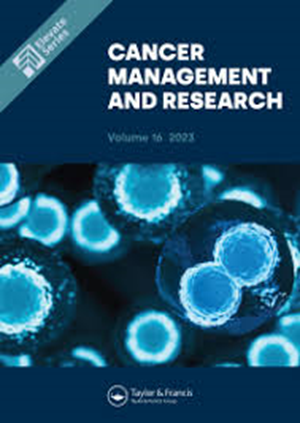基于多模态机器学习的乳腺纤维瘤原位导管癌预测
IF 2.5
4区 医学
Q3 ONCOLOGY
引用次数: 0
摘要
目的利用多模态机器学习方法建立一个临床放射组学模型,用于区分乳腺导管原位癌(DCIS)和乳腺纤维瘤病:回顾性收集了306名患者(198名DCIS患者)的临床因素、超声特征和相关超声图像。开发队列和验证队列中的患者分别为 184 人和 122 人。通过多变量逻辑回归分析确定的独立临床和超声因素被用于构建临床-超声模型。然后,划定乳腺病变的感兴趣区并提取放射组学特征。对六种机器学习算法进行了训练,以建立放射组学模型。选择预测能力更强、更稳定的算法,将结果输出转换为 Radscore。然后,将独立的临床预测因子和 Radscore 纳入逻辑回归分析,生成临床-放射组学联合模型。通过接受者操作特征曲线分析、DeLong 检验和决策曲线分析,比较了三种不同模型的预测能力和临床疗效:结果:在六个分类器中,逻辑回归模型被选为最终的放射组学模型。此外,临床-放射组学联合模型在区分DCIS和乳腺纤维瘤病方面的能力优于临床-超声模型和放射组学模型:综合临床超声因素和放射组学特征的联合模型在预测DCIS方面表现良好,可促进及时干预以改善患者的早期诊断和预后。本文章由计算机程序翻译,如有差异,请以英文原文为准。
Multimodal Machine Learning-Based Ductal Carcinoma in situ Prediction from Breast Fibromatosis
Objective: To develop a clinical-radiomics model using a multimodal machine learning method for distinguishing ductal carcinoma in situ (DCIS) from breast fibromatosis.
Methods: The clinical factors, ultrasound features, and related ultrasound images of 306 patients (198 DCIS patients) were retrospectively collected. Patients in the development and validation cohort were 184 and 122, respectively. The independent clinical and ultrasound factors identified by the multivariable logistic regression analysis were used for the clinical-ultrasound model construction. Then, the region of interest of breast lesions was delineated and radiomics features were extracted. Six machine learning algorithms were trained to develop a radiomics model. The algorithm with higher and more stable prediction ability was chosen to convert the output of the results into the Radscore. Further, the independent clinical predictors and Radscore were enrolled into the logistic regression analysis to generate a combined clinical-radiomics model. The receiver operating characteristic curve analysis, DeLong test, and decision curve analysis were adopted to compare the prediction ability and clinical efficacy of three different models.
Results: Among the six classifiers, logistic regression model was selected as the final radiomics model. Besides, the combined clinical-radiomics model exhibited a superior ability in distinguishing DCIS from breast fibromatosis to the clinical-ultrasound model and the radiomics model.
Conclusion: The combined model by integrating clinical-ultrasound factors and radiomics features performed well in predicting DCIS, which might promote prompt interventions to improve the early diagnosis and prognosis of the patients.
Keywords: multimodal machine learning, clinical-ultrasound features, radiomics, ductal carcinoma in situ
Methods: The clinical factors, ultrasound features, and related ultrasound images of 306 patients (198 DCIS patients) were retrospectively collected. Patients in the development and validation cohort were 184 and 122, respectively. The independent clinical and ultrasound factors identified by the multivariable logistic regression analysis were used for the clinical-ultrasound model construction. Then, the region of interest of breast lesions was delineated and radiomics features were extracted. Six machine learning algorithms were trained to develop a radiomics model. The algorithm with higher and more stable prediction ability was chosen to convert the output of the results into the Radscore. Further, the independent clinical predictors and Radscore were enrolled into the logistic regression analysis to generate a combined clinical-radiomics model. The receiver operating characteristic curve analysis, DeLong test, and decision curve analysis were adopted to compare the prediction ability and clinical efficacy of three different models.
Results: Among the six classifiers, logistic regression model was selected as the final radiomics model. Besides, the combined clinical-radiomics model exhibited a superior ability in distinguishing DCIS from breast fibromatosis to the clinical-ultrasound model and the radiomics model.
Conclusion: The combined model by integrating clinical-ultrasound factors and radiomics features performed well in predicting DCIS, which might promote prompt interventions to improve the early diagnosis and prognosis of the patients.
Keywords: multimodal machine learning, clinical-ultrasound features, radiomics, ductal carcinoma in situ
求助全文
通过发布文献求助,成功后即可免费获取论文全文。
去求助
来源期刊

Cancer Management and Research
Medicine-Oncology
CiteScore
7.40
自引率
0.00%
发文量
448
审稿时长
16 weeks
期刊介绍:
Cancer Management and Research is an international, peer reviewed, open access journal focusing on cancer research and the optimal use of preventative and integrated treatment interventions to achieve improved outcomes, enhanced survival, and quality of life for cancer patients. Specific topics covered in the journal include:
◦Epidemiology, detection and screening
◦Cellular research and biomarkers
◦Identification of biotargets and agents with novel mechanisms of action
◦Optimal clinical use of existing anticancer agents, including combination therapies
◦Radiation and surgery
◦Palliative care
◦Patient adherence, quality of life, satisfaction
The journal welcomes submitted papers covering original research, basic science, clinical & epidemiological studies, reviews & evaluations, guidelines, expert opinion and commentary, and case series that shed novel insights on a disease or disease subtype.
 求助内容:
求助内容: 应助结果提醒方式:
应助结果提醒方式:


